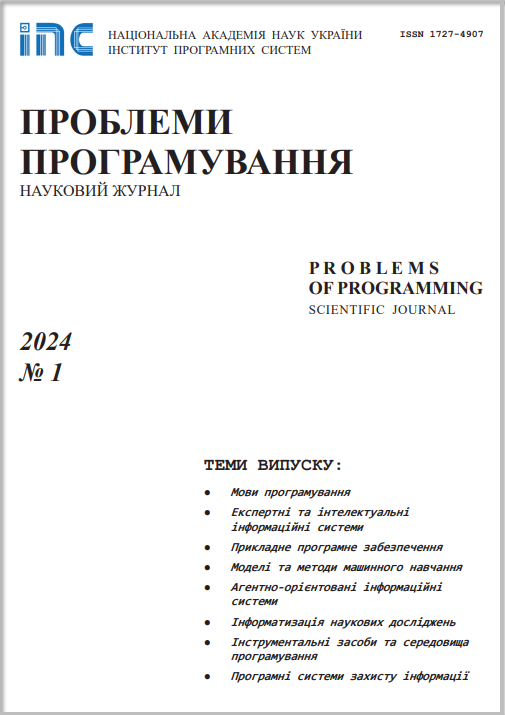Multiagent models based on fuzzy logic of the highest type for a high-performance environment
Abstract
Keywords
Full Text:
PDF (Українська)References
Macal C., North M. Аgent-based modeling and simulation for exascale computing. – SciDAC Review, Summer 2008. – P. 34–41.
Zadeh L.A. Fuzzy Logic = Computing With Words// IEEE Transactions on Fuzzy Systems. – 1996. – Vol. 4. – P. 103–111.
Zadeh L. A. The concept of a linguistic variable and its application to approximate reasoning // Information Sciences. – 1975. – Vol.8, N 8. – P. 199–249, P. 301–357.
Mendel J.M., John R.I. Type-2 sets made simple // IEEE Trans. on Fuzzy Systems. – 2002. – Vol.10, N 2. – P. 117–127.
Karnik N.N., Mendel J.M., Liang Q. Type-2 fuzzy logic system // IEEE Trans. on Fuzzy Systems. – 1999. – Vol.7, N 6. – P. 643–658.
Парасюк И.Н., Ершов С.В. Трансформационный подход к разработке интеллектуальных агентов на основе нечетких моделей // Проблеми програмування. – 2011. – № 2. – C. 62–78.
Парасюк И.Н., Ершов С.В. Нечеткие модели мультиагентных систем в распределенной среде // Проблеми програмування. – 2010. – № 2–3. – C. 330–339.
Парасюк И.Н., Ершов С.В. Моделе-ориентированная архитектура нечетких мультиагентных систем // Компьютерная математика. – 2010. – № 2. – C.139–149.
Ершов С.В. Принципы построения нечетких мультиагентных систем в распределенной среде // Там же. – 2009. – № 2. – C. 54–61.
Mendel J.M. Type-2 fuzzy sets and systems: an overview // IEEE Computational Intelligence Magazine. – 2007. – Vol. 2. – P. 20–29.
Wang D., Zeng X., Keane J. A survey of hierarchical fuzzy systems // International Journal of Computational Cognition. – 2006. – Vol. 4, N 1. – P. 18–29.
Суперкомпьютеры ИК НАН Украины. – http://icybcluster.org.ua.
International Electrotechnical Commission (IEC). Technical Committee No. 65: Industrial Process Measurement and Control. IEC 1131 – Programmable Controllers Part 7 – Fuzzy Control Programming. – http://www.fuzzytech.com/binaries/ieccd1.pdf
Bellifemine F., Caire G., Greenwood D. Developing Multi-Agent Systems with JADE. – Chichester: John Wiley & Sons Inc, 2007. – 303 p.
Eclipse Modeling Framework. – http://wiki.eclipse.org/EMF/
MOF 2.0/XMI Mapping. – http://www.omg.org/spec/XMI/2.1.1/
OMG MetaObject Facility. – http://www.omg.org/mof/
Graphical Modeling Framework. – http://www.eclipse.org/modeling/gmp/
Application Design Patterns: Producer/Consumer. – http://zone.ni.com/devzone/cda/tut/p/id/3023/
Perini А., Susi A. Automating model transformations in agent-oriented modeling // Agent-oriented software engineering VI. Lecture notes in computer science. – Springer, 2006. – P. 167–178.
Pavon J., Gomez-Sanz J. Agent-oriented software engineering with INGENIAS // Multi-agent system and applications III. Lecture notes in computer science. – Springer, 2003. – P. 8–38.
Wooldridge M.J. An Introduction to Multiagent Systems. – Cambridge: MIT Press, 2002. – 366 p.
Reynolds C.W. Flocks, herds and schools: a distributed behavioural model // Comput. Graph. – 1987. – Vol.21, N 4. – P. 25–34.
Refbacks
- There are currently no refbacks.

